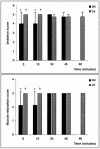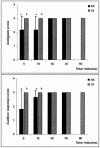Comparison of medetomidine-ketamine and dexmedetomidine-ketamine anesthesia in golden-headed lion tamarins
- PMID: 15283517
- PMCID: PMC548631
Comparison of medetomidine-ketamine and dexmedetomidine-ketamine anesthesia in golden-headed lion tamarins
Abstract
The cardiovascular, respiratory, and anesthetic effects of medetomidine-ketamine (20 microg/kg bodyweight [BW] and 10 mg/kg BW) (MK group) or dexmedetomidine-ketamine (10 microg/kg BW and 10 mg/kg BW) (DK group) were studied in golden-headed lion tamarins. Heart rate decreased after administration of both combinations; this reduction was statistically greater in the DK group than in the MK group after 15 and 45 minutes. Systolic arterial pressure decreased in a similar way in both groups, except at 15 minutes, when systolic arterial pressure was significantly lower in the DK group. Diastolic arterial pressure, mean arterial pressure, respiratory rate, and rectal temperature were progressively reduced in all groups. Sedation time was significantly shorter and anesthesia time was significantly longer in the DK group compared with MK group. Anesthetic quality and analgesia scores were significantly greater at 5 and 15 minutes in the DK group compared with the MK group. The administration of dexmedetomidine-ketamine is as safe and effective as the administration of medetomidine-ketamine in tamarins.
Résumé — Comparaison des anesthésies à la médétomidine-kétamine et à la dexmédétomidine-kétamine chez le tamarin à tête dorée. Les effets cardiovasculaires, respiratoires et anesthésiques de la médétomidine-kétamine (20 μg/kg de poids corporel (PC) et 10 mg/kg PC) (groupe MK) ou de la dexmédétomidine — kétamine (10 μg/kg/PC et 10 mg/kg PC) (groupe DK) ont été étudiés chez le tamarin à tête dorée. La fréquence cardiaque a diminué après l’administration des 2 associations; cette diminution était statistiquement plus importante chez le groupe DK que chez le groupe MK après 15 et 45 minutes. La pression artérielle systolique a diminué de façon similaire chez les 2 groupes, sauf à 15 minutes, alors que la pression artérielle systolique était significativement plus basse chez le groupe DK. La pression artérielle diastolique, la pression artérielle moyenne, la fréquence respiratoire et la température rectale diminuaient progressivement chez tous les groupes. Le temps de sédation était significativement plus court, le temps d’anesthésie était significativement plus long chez le groupe DK comparé au groupe MK. La qualité de l’anesthésie et les cotations analgésiques étaient significativement plus grandes à 5 et 15 minutes chez le groupe DK en comparaison avec le groupe MK. L’administration de dexmétomidinekétamine est aussi sécuritaire et efficace que l’administration de médétomidine-kétamine chez le tamarin.
(Traduit par Docteur André Blouin)
Figures


Similar articles
-
Assessment of dexmedetomidine/ketamine anesthesia in golden-headed lion tamarins (Leontopithecus chrysomelas).Vet Anaesth Analg. 2004 Apr;31(2):138-45. doi: 10.1111/j.1467-2987.2004.00147.x. Vet Anaesth Analg. 2004. PMID: 15053752 Clinical Trial.
-
A comparison of medetomidine and its active enantiomer dexmedetomidine when administered with ketamine in mice.BMC Vet Res. 2013 Mar 13;9:48. doi: 10.1186/1746-6148-9-48. BMC Vet Res. 2013. PMID: 23497612 Free PMC article.
-
Medetomidine-ketamine-butorphanol anesthetic combinations in binturongs (Arctictis binturong).J Zoo Wildl Med. 2003 Dec;34(4):346-51. doi: 10.1638/03-016. J Zoo Wildl Med. 2003. PMID: 15077709
-
COMPARISON OF ETORPHINE-ACEPROMAZINE AND MEDETOMIDINE-KETAMINE ANESTHESIA IN CAPTIVE IMPALA (AEPYCEROS MELAMPUS).J Zoo Wildl Med. 2015 Dec;46(4):870-9. doi: 10.1638/2015-0114.1. J Zoo Wildl Med. 2015. PMID: 26667544 Clinical Trial.
-
Effects of a microdose of medetomidine on diazepam-ketamine induced anesthesia in dogs.J Am Vet Med Assoc. 1998 Jul 15;213(2):215-9. J Am Vet Med Assoc. 1998. PMID: 9676590 Clinical Trial.
Cited by
-
Comparison of three different sedative-anaesthetic protocols (ketamine, ketamine-medetomidine and alphaxalone) in common marmosets (Callithrix jacchus).BMC Vet Res. 2013 Jun 11;9:113. doi: 10.1186/1746-6148-9-113. BMC Vet Res. 2013. PMID: 23758836 Free PMC article. Clinical Trial.
-
Safety and Efficacy of Ketamine Versus Ketamine-Fentanyl-Dexmedetomidine Combination for Anesthesia and Analgesia in Rats.Dose Response. 2019 Feb 12;17(1):1559325819825902. doi: 10.1177/1559325819825902. eCollection 2019 Jan-Mar. Dose Response. 2019. PMID: 30792614 Free PMC article.
-
Current Topics in Marmoset Anesthesia and Analgesia.ILAR J. 2020 Dec 31;61(2-3):218-229. doi: 10.1093/ilar/ilab001. ILAR J. 2020. PMID: 33580955 Free PMC article. Review.
-
Comparison of the effects of ketamine, ketamine-medetomidine, and ketamine-midazolam on physiologic parameters and anesthesia-induced stress in rhesus (Macaca mulatta) and cynomolgus (Macaca fascicularis) macaques.J Am Assoc Lab Anim Sci. 2010 Jan;49(1):57-63. J Am Assoc Lab Anim Sci. 2010. PMID: 20122318 Free PMC article.
-
Discrimination of Stereoisomers by Their Enantioselective Interactions with Chiral Cholesterol-Containing Membranes.Molecules. 2017 Dec 25;23(1):49. doi: 10.3390/molecules23010049. Molecules. 2017. PMID: 29295605 Free PMC article.
References
-
- Nowak RM, ed. Walker’s Mammals of the World. 5th ed. Baltimore: John Hopkins Univ Pr, 1991:435–444.
-
- Valladares-Pádua C. Biology and conservation: family Callitrichidae. In: Fowler ME, Cubas ZS, eds. Biology, Medicine, and Surgery of South American Wild Animals. Ames: Iowa State Univ Pr, 2001: 259–261.
-
- Bush M. Methods of capture, handling, and anesthesia. In: Kleinman DG, Allen ME, Thompson KV, Lumpkin S, eds. Wild Animals in Captivity — Principles and Techniques. Chigaco: Univ Chicago Pr, 1996:37–38.
-
- Wallach JD, Boever WJ. Immobilizing agents for primates. In: Wallach JD, Boever WJ, eds. Diseases of Exotic Animals — Medical and Surgical Management. 1st ed. Philadelphia: WB Saunders, 1983:19.
-
- White GL, Cummings JF. Comparison of ketamine and ketamine-xylazine in the baboon. Vet Med Small Anim Clin. 1969;74:392–396. - PubMed
Publication types
MeSH terms
Substances
LinkOut - more resources
Full Text Sources
